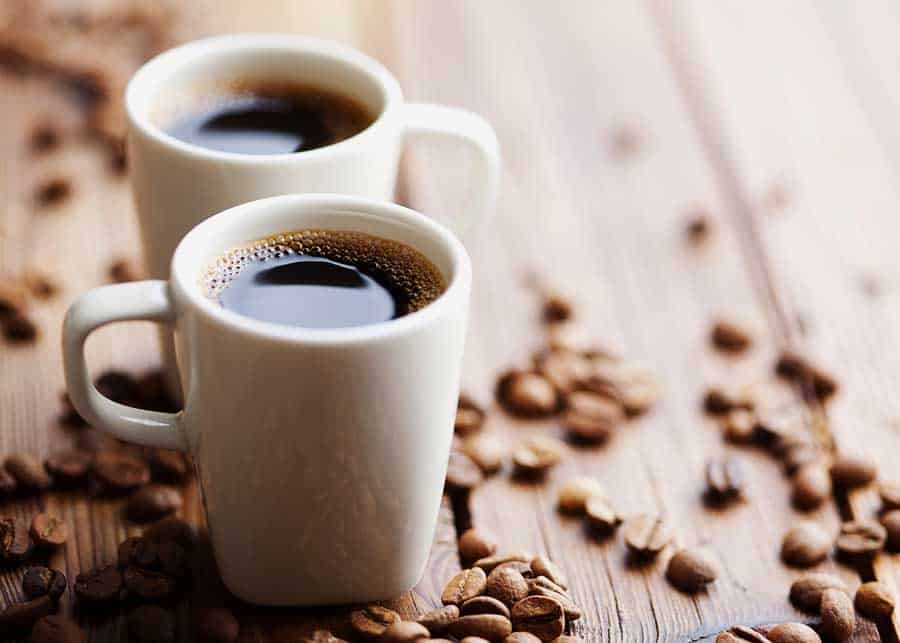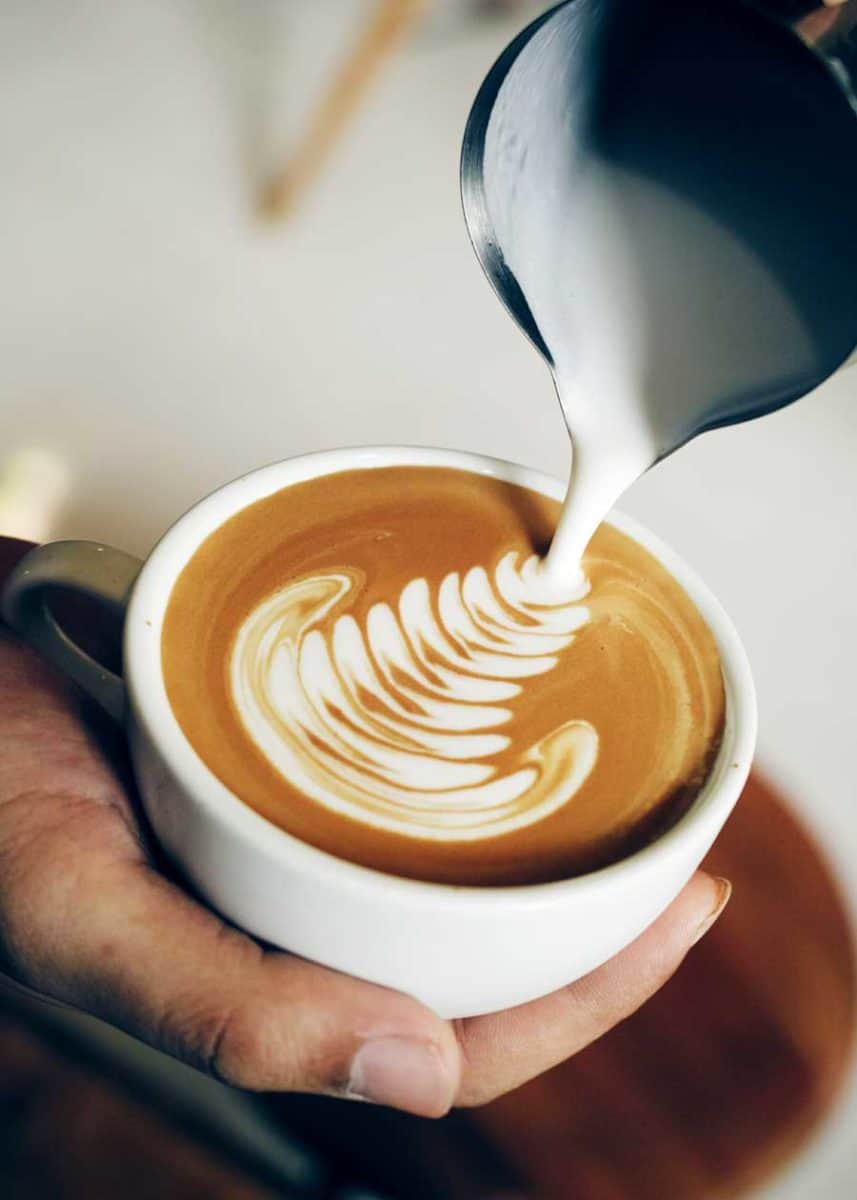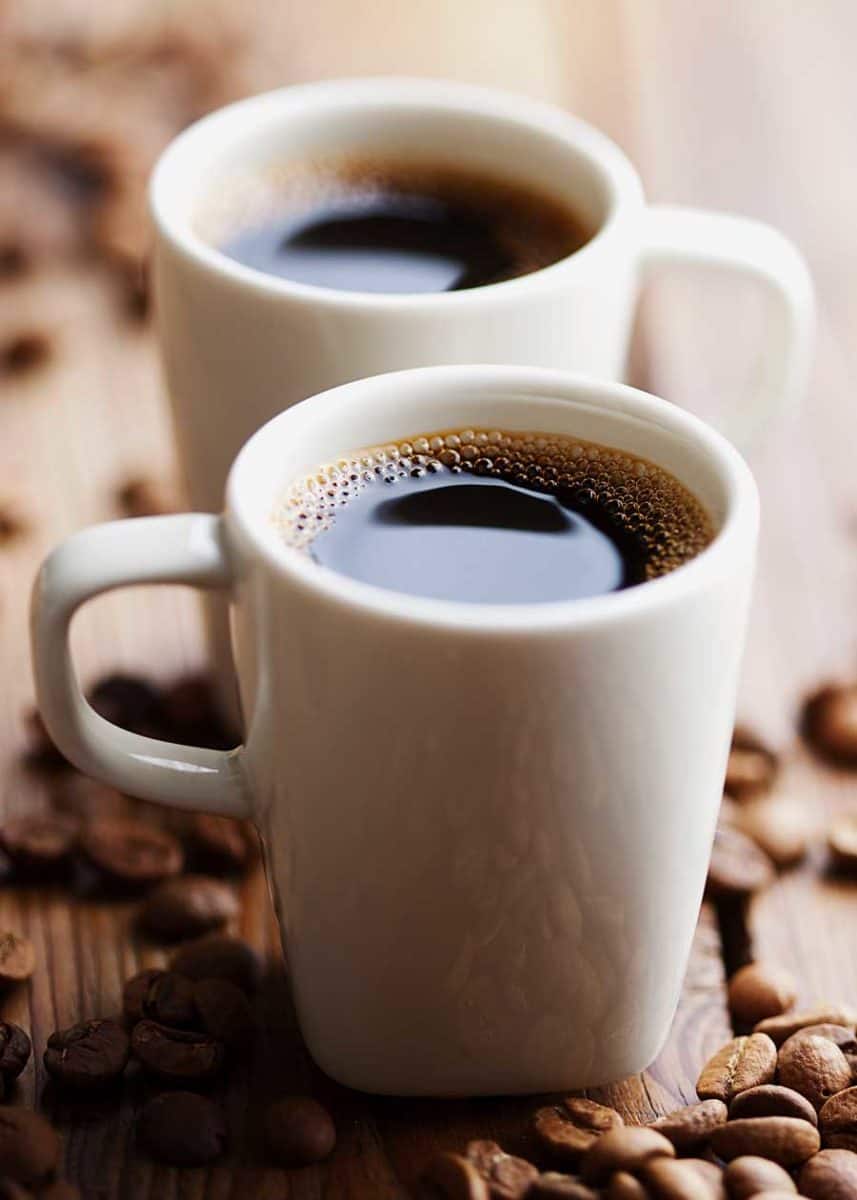Some coffee drinkers make fun of a latte as overly fancy. But what’s a cup of coffee, really? Does a latte have coffee? And what’s the difference between coffee and latte? In this post, we’ll explain the differences.
Lattes are a delicious drink crafted using an espresso base, combined with steamed milk, and topped with foamed milk. It’s more than a simple drip coffee. Key differences between a latte vs coffee include brew method, taste, caffeine, and versatility. Lattes contain espresso, not drip coffee.

Table of Contents
4 Key Differences: Latte vs Coffee
While a latte uses espresso, a type of coffee, there are several notable differences between a latte and a cup of coffee.
1. Brewing Processes
The brewing process is one of the key differences between latte and coffee.
Brewing a pot of coffee is a very different process from crafting a latte. Even within brewing a standard cup of coffee, the process varies widely. Here are 17 different brew methods.
Lattes Use Espresso
Lattes are a combination of espresso, steamed milk, and foamed milk. The art of pulling the perfect shot of espresso requires the perfect grind and the optimum pressure. Fortunately, a generous helping of steamed milk helps cover up any flaws in the technique.
Is Sugar Added to Lattes? Not really. The actual drink doesn’t call for any added sugar. But as the following reference shows, there is still a lot of sugar from the added milk.
Caffè latte, also sometimes simply referred to as a latte, is made from espresso, steamed milk, and a light layer of foam.
Although many people choose to add sweeteners to their latte, the drink itself is free of added sugar. Still, it contains 18 grams of milk sugar in each 16-ounce (473-mL) serving.
Healthline
The amount of sugar will change if you use non-dairy milk, for example, a cup of unsweetened almond milk will only add about 2 grams of sugar to your latte.
More Than Drip
The old-fashioned Mr. Coffee drip machine comes to mind when thinking of coffee. It doesn’t have to be that way, and a world of methods exists to produce the best coffee available.
The pour-over, french press, and vacuum siphons make a range of coffee flavors and aromas. The world is better for having more than instant coffee.

2. Taste Latte vs. Coffee
Taste goes into deciding whether to brew coffee or get a latte.
Both lattes and coffees start bitter, and both can be sweet thanks to plenty of creamers, sugars, and flavoring.
What Does a Latte Taste Like?
A latte has a relatively mild, milky flavor on account of the ratio of milk to espresso. It also helps that many coffee houses load up the sugar with sweeteners ranging from vanilla to egg nog.
If there’s a syrup, there’s a latte for it. A latte also has a foamy top that adds to the flavor making the overall beverage that much more creamy.
Lattes are also excellent hot or iced, and some lattes don’t even use espresso as a base but rather a tea, like a Chai latte or London Fog.
What Does a Coffee Taste Like?
The taste of a cup of coffee varies depending on the coffee beans you use (grind size and darkness of roast) and what brewing process you decide to use. A press, for example, will produce coffee that’s more rich and full-bodied.
A cup of black coffee will usually have some bitterness, it could taste mild with notes of floral and citrus, or strong with notes of nuts and caramel. There is an exciting variety of flavor notes to be explored!
Mild coffees benefit from the pour-over method, where flavors really come through more pronounced. There’s also plenty of milk, creamer, sugar, and syrups to flavor anything too bitter.

3. Caffeine Content
Do lattes have more caffeine than coffee? That depends on the size of your latte, or coffee.
Reaching for a latte which usually has a double shot of espresso will give you a little more caffeine than a regular cup of coffee.
Caffeine Content of a Latte
The caffeine content in lattes depends on how much espresso goes into it. Coffee shops usually use a double shot of espresso with a ratio of 1/3 espresso to 2/3 steamed milk, with a little foam on top. This means that a typical latte has around 130 milligrams of caffeine.
You can really load up a latte with extra espresso shots as well which will up the caffeine content.
Caffeine Content of Coffee
A standard cup of coffee has 95 milligrams of caffeine per cup of coffee. Of course, that’s the average cup, with several types rating well over that.
There’s some evidence to support the idea that a darker roast does not have more caffeine, but a blond roast pumps out more of the addictive substance. There’s even decaf coffee for lovers of flavor without the jitters.
4. Beverage Versatility
Variety is the spice of life, so having the same cup of coffee every morning can get pretty dull.
Lattes promise a world of flavors, but are they more versatile than a regular cup of coffee?
The Versatility of a Latte
Lattes are one of the most versatile beverages on the planet. You can have it hot or iced, with espresso or tea, flavored or caffe latte. There are dedicated recipes for any time of year.
You can substitute the milk for almond milk, soy milk, or heavy cream alternatives. There’s virtually nothing you can’t do with a latte.
The Versatility of Coffee
While the latte claims to be one of the most versatile coffees, a regular cup of coffee can come in just as many varieties.
Brewing a coffee starts with deciding which process to use and how to enjoy it. Experimenting with the grind size, darkness of roast, and brewing method is a world of flavor variation in itself. With the addition of cream, sugar alternatives, milk, or other flavorings, there is no shortage of options. Plus, you can add whip cream without changing the name!
Which is Better, Latte or Coffee?
Latte or coffee? That is the question.
- While a latte promises great flavor, the milk can be a bit much for some.
- A cup of coffee seems basic but gets complex quickly if you’re chasing the best brew. Either way, enjoying a beverage brewed from roasted beans is the best way to get your daily caffeine fix.
If you aren’t a big fan of strong coffee, a latte is probably a good choice.
Learn more about other types of coffee.

Keep learning: Americano vs Drip Coffee (3 Differences)
Final Thoughts on Latte vs. Coffee
A latte is the go-to drink of coffee shops worldwide. A cup of coffee is the first beverage millions wake up to when starting their day.
What’s the difference? They both provide a jolt of caffeine and come from roasted beans. There are actually several differences, from taste and brewing methods to caffeine content and versatility. These key differences make up unique flavor profiles worth spending time enjoying.
Which is your preference: latte or drip coffee?
- About the Author
- Latest Posts
Dena Haines is a co-founder and blogger on EnjoyJava – and is working to make it the best coffee blog in the world.
She also blogs about travel at Storyteller.Travel and photography at Storyteller Tech. Dena is a partner at Storyteller Media, a publishing company she started with her husband, Bryan.
